-

人教版新目标初中英语八年级上册How do you make a banana milk shake教案2篇
1. First, ... then, ... next, ... finally, ...首先,……然后,……接着,……最后,……这是英语中表达做某事的步骤的一种说法。如果步骤较多,还可以说:first-next-after that-later on-finally/at last通常你会听到说英语国家的人在说 first, next, then, finally 和后面的内容时,他们会做一些停顿。这样就能提前告诉听者接下来讲的是一系列的步骤。这一点在朗读和听力中应特别注意。2. how many, how much均为疑问词,同是“多少”,但用法不同。请看:how many修饰可数名词复数,how much修饰不可数名词。但在用法上,同学们常犯如下错误:1) [误] How many are there bananas on the table?[正] How many bananas are there on the table?[析] how many, how much 中的many,much是形容词,常修饰名词作定语,故后面跟名词。2) [误]How much tea are there on the table?[正]How much tea is there on the table?[析] how much修饰不可数名词时,谓语动词用单数。how many与how much的区别可简记为:前how many:问“多少”,复数名词后面跑;how much问“多少”,不可数名词单数好。前者答语用基数词,后者答语用数量关系。

人教版新目标初中英语八年级上册Could you please clean your room教案3篇
一、 教学内容Section A 1a----1c二、 教学目标1.学习词汇do the dishes, make the bed, take out the trash, fold the clothes, do the laundry, sweep the floor, clean the living room.2.句型 Could you please clean your room? Yes, sure.三、 教学准备 学生预习本单元所有的词汇多媒体课件 活动表 奖品四、 教学过程Pre-task1. Warming upEnjoy ourselves. Watch cartoon Cinderella. 看动画片段《灰姑娘》导如入本课话题和新词汇“chores”美丽善良的鬼姑娘因继母的嫉妒,每天得做所有的家务。片段的主题使学生联想到本课的话题。2. learn new words and phrasesLook! What is she / he dong? 看图学习动词词组do chores, do the dishes, make the bed, take out the trash, fold the clothes, do the laundry, clean the living room.3. Guessing game.What is she doing ? 4. Pair work. 1a, Do you do these things at home? Write “Y” for “yes” and “N” for “no”.5. Listening . 1b , Peter’s chores or Mom’s chores?理解目标语Could you please clean your room? Yes, sure.Write “M” for Mom’s chores, “P” for Peter’s chores in the chart.6. PairworkLook at the picture,Ask your partner to do the chores that you see. 7. Interview Who is the most able at home? 1) What chores do you do at home? How often do you do the chores? Work in four, interview each of the students in the group, fill in the chart.

人教版新目标初中英语八年级上册How do you get to school教案2篇
Step Ⅶ Role play ( Work on 1b)1. First ask two students to read the dialogue to the class.Sa: How do you get to school?Sb: Well, I ride my bike to the subway station. Then I take the subway.2. Now work with a partner.Suppose you use two kinds of transportation to get to school \Hangzhou\Beijing... (bus, train, subway, walking, bike, etc.) Tell how you get there. You may use the phrases in 1a.3. Then ask different pairs of students to present their conversations to the class.Step ⅧListening1. Work on 2a(1) First ask students to read the list of information that Thomas wants to know.…where Nina lives.…how far from school she lives.…how long it takes to get to school.…how she gets to school.…what she thinks of the transportation.(2) Tell students what transportation and bus stop mean.bus stop 汽车站 transportation n. 运送;运输Then tell students we'll hear a recording. Please put a checkmark in front of each thing that Thomas wants to know.(3) Now play the recording for students.( Have students pay attention to the sample answer.) (4) Then correct the answers.

人教版新目标初中英语八年级上册What are you doing for vacation教案2篇
Teaching goals : 1. Words & phrases: babysit ,get back , fishing , rent , think about , decide(on) , tourist etc. 2. How to talk about future plans . 3. 现在进行时表示将来计划或行动. 4. 特殊疑问句(where , when , how long引导) Important and difficult points : Drills :What are you doing for vacation ? I’m watching TV . When are you going ? I’m going … . How long are you staying ? We’re staying for five days . Teaching aids : cards and a tape ,a large wall calendar . Period 1 Teaching procedures : Step 1Leading in1. Free talk . 2. Put up the wall calendar . T: I’m staying home on Saturday (pointing to next Saturday ).Ss repeat . Ss: I’m staying home on Saturday . T: OK. Today we’ll learn how to talk about future plans. Step 2Pre-task SB Page 13 , 1a . 1. Look at the picture carefully and tell what you see in the picture . 2. Write the activities from the pictures in the box and add some more . 3. Practice reading . Step 3While-task1. Using the activities we write in 1a to make conversations .For example :What are you doing for vacation ? I’m visiting my uncle . 2. Pairwork .Practice in pairs . 3. 用第三人称练习对话.

人教版新目标初中英语八年级上册What’s the matter教案2篇
She shouldn’t go to the party tonight.Step7. TaskT: You know, there are lots of problems in our life. If you are a doctor, please tell us how to solve the problem. I will divide you into 9 groups. Please work in groups. And then choose one of you to report your ideas.The following are the problems:I have a toothache.I am hungry. I have a sore throat.I am stressed out. I have a sore back.I am tired. I can’t sleep.I have a cold. I have a headache.Report: If you have a headache, you should go to bed early. You should see the doctor. You should eat some medicine. You shouldn’t wash your face with cold water.You shouldn’t sleep late.You shouldn’t swim.…..T encourages the students to give advice as much as possible.Homework:1. Chose one of the problems, and write down your advice2. Copy the new words这一步是用于热身的,同时也可以让他们复习一部分的表示人体部位的单词,扩充知识.学习语言的过程也是一个不断积累的过程,复习旧知识,增添新知识.通过小游戏,强化学生对Does she/he have…这个句子的运用能力.通过复习,自然的引到下面新知识的学习。充分利用表格,由句子到对话,再到文章,让学生循序渐进. 提高学生的综合语言运用能力,运用以前学过的知识来解决身边的问题.Period 5 (Section B 3a—3c, selfcheck)教学内容与分析:

人教版新目标初中英语七年级上册Can you play the guitar教案
本单元主要是学习情态动词can的肯定句、否定句、一般疑问句,肯定与否定回答,以及特殊疑问句的构成和用法;复习what弓!导的特殊疑问句。本单元主要围绕“加人俱乐部,谈论自己的能力”这一话题,设计了三个任务型活动:任务一是:自己的才艺表演,学习情态动词can的用法;任务二是:自己建立俱乐部,运用情态动词can谈论自己在某一方面的能力、喜好和意愿;任务三是:我能成功,主要是复习巩固谈论各自的爱好和特长的方法。单元知识系统(树)Can you/he/she/you dance? 一Yes,I/he/she/we can./No,I/he/she/we can’t.Can Bill play the guitar?一Yes,he can,but he can’t sing.单元总体目标通过学习情态动词can的用法,使学生能够表达自己在某一方面所具备的才能;能够谈论自己的喜好与意愿;能够为自己成立的各种俱乐部制作海报;会写招聘广告。单元重难点一览重点 难点I.复习词汇:can,play,want2.词汇:guitar, dance, swim,sing, chess, speak, drum,trumpet,violin,play the guitar3.句型:Can you/he/she/you dance?Yes,I/he/she/we can./No,I/he/she/we can’t.Can Bill play the guitar?

人教版新目标初中英语七年级上册How much are these pants教案
个性练习设计 阅读广告:在日常生活中,人们去买东西之前,一般要阅读广告,从广告中获取该商品的一些有用信息,包括价格、性能等。所以给学生提供有些商品的广告或让学生去商店去阅读一些商品的广告,从中获取商品的价格,即可以锻炼学生的阅读能力,又能提高实践能力。 Self Check 教学内容 Self Check(教材P42) 教学目标 知识与能力 复习词汇pant,sock,T-shirt,sweater,shoes,color,black,white,red,green,blue,big,short,long,数字10--31; 学习词汇Zig Zag,clothes,shop,yellow,ask,which;学会谈论服装的价格、颜色、大小和长短;学会填写价格标签。 过程与方法 运用Summarizing和Classifying的学习策略。在复习教学中,运用听写、绘画、互相询问调查与检测等手段,促使学生不断地使用所学内容,从而提高他们灵活运用知识的能力。 情感态度价值观 该部分学习内容主要是复习谈论服装的价格和颜色以及对服装的喜好,能引起学生的共鸣;通过购物的对话练习教学生学会购物时使用的礼貌用语和如何感谢人。

人教版新目标初中英语八年级上册How was your school trip教案2篇
“Go for it!” is based on “Task-Based Language Teaching”. It adheres to “The authenticity principle”, “The form-function principle”, “The task dependency principle” and “The principle of learning by doing”. These principles all accord with the demands of curriculum focus.In and of Grade Seven (II), “Go for it!”, students have learned “The Simple Past Tense”. And it appears again in of Grade Eight (I). teaches students more about how to talk about events in the past. In addition, it gives affirmative and negative statements in the past tense, such as the sentence patterns “Did you see …?” “Were there …?” “Did you go …?” As the first part of Unit 8, Section A opens with a picture presenting the last school trip in the aquarium and continues with several step-by-step practice activities, which are all good for students to master “The Simple Past Tense”. Doing well in Section A will help students integrate the new target language with that in Section B. Thus, they can describe the events in the past freely and foster their own ability of reflecting and practicing. II. Teaching ObjectivesTeaching objective is the beginning and aim of teaching activities. According to the overall goal of the English elementary course--- improve students' synthetic ability of language application, which should be based on the development of students’ “Language knowledge”, “Language skills”, “Character building”, “Learning strategies” and “Cross-cultural awareness”. The teaching objectives are described as follows(I). Knowledge objectivesi. Master the simple past tense of regular and irregular verbsii. Recite the new words and expressions about the last school trip in the aquarium, including their pronunciation and intonation

人教版新目标初中英语八年级上册I’m going to be a basketball player教案3篇
教学目标1.知识目标:(1)学习What are you going to be when you grow up?/How are you going to do that?句式。(2)学会用英语描述有关职业的表达法。2.能力目标:(1)能够谈论为实现理想所做出的打算和安排。(2)能够谈论未来自己与他人理想的职业及原因。(3)能用英语描述课余时间的活动安排,最终具备表达综合信息的能力。3.情感目标:新学期到来之际,让他们在学习、体育、饮食、特长、读书等方面制定计划,教育学生合理安排自己的课外生活,思考自己的理想职业及适合自己的职业。教学重点、难点本单元的重点为“be going to”表将来,want to be, what,where, when,how引导的特殊疑问句。难点是语言目标的实现。教材分析本单元以I am going to be a basketball player为话题,共设计了三部分的内容:一、Section A该部分有4个模块。第一模块围绕Do you think these jobs are interesting?这一话题展开思维(1a)、听力(1b)、口语(1c)训练;

人教版新目标初中英语八年级上册I’m more outgoing than my sister教案2篇
1 交通工具的比较此活动为小组活动。学生通过讨论找出到达某一城市可乘坐的各种交通工具,并选择最佳出行方式。Teacher:We’re going to Shanghai. How many ways can we use to get there? Yes, there are four ways: by bus, by plane, by train, by ship. Please discuss how you are going to get there.操作建议:(1)学生以小组为单位展开活动,谈论本组所选择的交通工具。(2)各组选代表向全班汇报,阐述本组所选择的交通工具的利和弊。完成任务所需要的语言结构:We can go there by ship. It’s more comfortable and cheaper than any other transportation.We can go there by bus. It’s cheaper but it takes longer time.2 哪个城市更合适?此活动具有挑战性。假设中国要举行2014年世界杯足球赛,分别从历史,人文,天气等方面对各城市(北京,大连,上海,昆明)进行比较,选择最佳举办城市。T: Imagine China is holding the 2014 FIFA World Cup. Which city do you think is the best for the World Cup, Beijing, Dalian, Shanghai or Kunming? Let’s work in groups. If you choose Beijing, please join the Team Red. If you chose Dalian, please join the Team White. If you choose Shanghai, please join the Team Blue. If you choose Kunming, please join the Team Green. Please show us its advantages. Then let’s see which team will win.
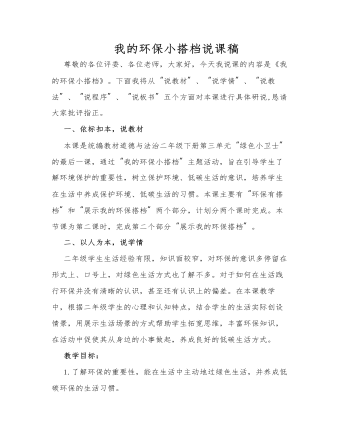
人教部编版道德与法制二年级下册我的环保小搭档说课稿
小结:相信随着科技的进步,会有更多的垃圾变宝贝,看来只要用心发现,动手创造,我们可以利用的环保小搭档可真不少。展示“家庭环保小搭档”环节,从学校生活过渡到家庭生活,以填表的形式降低学生交流难度。口头的交流不足以让学生有清晰的认识,课前已让学生搜集相关内容,通过图片、视频等内容展示分享,让学生对“环保小搭档”有更清晰的认识,在交流分享过程中,努力让学生意识到过有创意的绿色生活的重要性、必要性。活动四:“环保”知多少我们为环保助力的行为既是大家倡导的,也是受到法律保护的,开启环保之旅第四站——科普馆1.出示与环境保护有关的节日2.了解《中华人民共和国环境保护法》拓展补充有关中国及世界上有关环保的节日,同时了解《中华人民共和国环境保护法》。
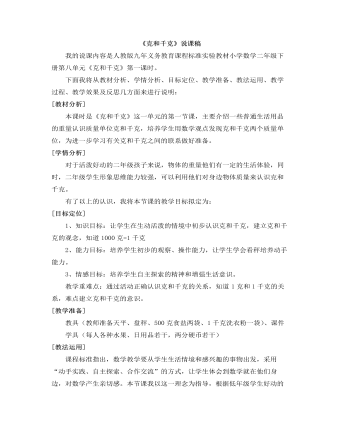
小学数学人教版二年级下册《克和千克》说课稿
[教材分析]本课时是《克和千克》这一单元的第一节课,主要介绍一些普通生活用品的重量认识质量单位克和千克,培养学生用数学观点发现克和千克两个质量单位,为进一步学习有关克和千克之间的联系做好准备。[学情分析]对于活泼好动的二年级孩子来说,物体的重量他们有一定的生活体验,同时,二年级学生形象思维能力较强,可以利用他们对身边物体质量来认识克和千克。有了以上的认识,我将本节课的教学目标拟定为:[目标定位]1、知识目标:让学生在生动活泼的情境中初步认识克和千克,建立克和千克的观念,知道1000克=1千克2、能力目标:培养学生初步的观察、操作能力,让学生学会看秤培养动手能力。3、情感目标:培养学生自主探索的精神和增强生活意识。教学重难点:通过活动正确认识克和千克的关系,知道1克和1千克的关系,难点建立克和千克的意识。

小学数学人教版一年级上册《0的认识》说课稿第二课时
尊敬的各位老师:大家好!我说课的内容是九年义务教育教科书[人教版]一年级数学上册三单元第七节《0的认识》。下面我从教材、学生、教法、学法、教学过程、板书、课后反思等几个方面谈谈对本节课的理解和设计。 一、说教材 1、教材简析: 日常生活中经常使用0,在不同场合,0往往有不同的意思。对此,教材有明确的要求。 (1)、着重教学“一个也没有,可以用0表示”。让学生在情景中体会0也是一个数,它的产生也是计数的需要。 (2)、结合直尺教学0,0还可以表示起点。 (3)、让学生体会0在生活中的广泛应用。 教材通过猴子吃桃的有趣情境引入,使学生直观体会到什么都没有可以用“0”来表示。接着利用直尺认识“0”还可以表示起点,并使学生进一步熟悉了数的顺序。在学习了“0”的书写后,利用小鸟等动物活动图学习有关“0”的加减法,使学生感受生活中的数学,快乐学习。 2、学习目标: 这节课我和学生要达到的学习目标是: (1)、通过观察感知,让学生知道0可以表示“没有”,还可以表示“起点”,并且会给数排列顺序。
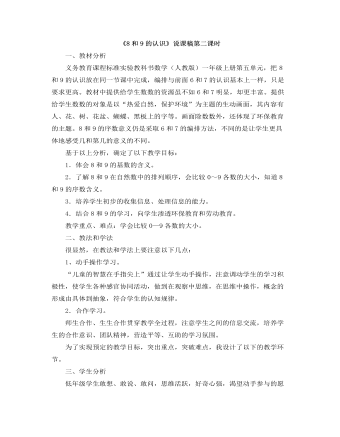
小学数学人教版一年级上册《8和9的认识》说课稿第二课时
一、教材分析义务教育课程标准实验教科书数学(人教版)一年级上册第五单元,把8和9的认识放在同一节课中完成,编排与前面6和7的认识基本上一样,只是要求更高。教材中提供给学生数数的资源虽不如6和7明显,却更丰富。提供给学生数数的对象是以“热爱自然,保护环境”为主题的生动画面,其内容有人、花、树、花盆、蝴蝶、黑板上的字等。画面除数数外,还体现了环保教育的主题。8和9的序数意义仍是采取6和7的编排方法,不同的是让学生更具体地感受几和第几的意义的不同。基于以上分析,确定了以下教学目标:1.体会8和9的基数的含义。 2.了解8和9在自然数中的排列顺序,会比较0~9各数的大小,知道8和9的序数含义。 3.培养学生初步的收集信息、处理信息的能力。 4.结合8和9的学习,向学生渗透环保教育和劳动教育。 教学重点、难点:学会比较0—9各数的大小。
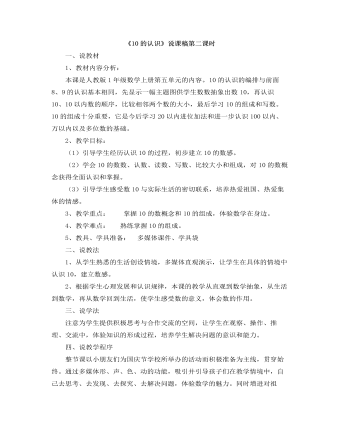
小学数学人教版一年级上册《10的认识》说课稿第二课时
一、说教材1、教材内容分析:本课是人教版1年级数学上册第五单元的内容。10的认识的编排与前面8、9的认识基本相同,先显示一幅主题图供学生数数抽象出数10,再认识10、10以内数的顺序,比较相邻两个数的大小,最后学习10的组成和写数。10的组成十分重要,它是今后学习20以内进位加法和进一步认识100以内、万以内以及多位数的基础。 2、教学目标: (1)引导学生经历认识10的过程,初步建立10的数感。 (2)学会10的数数、认数、读数、写数、比较大小和组成,对10的数概念获得全面认识和掌握。 (3)引导学生感受数10与实际生活的密切联系,培养热爱祖国、热爱集体的情感。 3、教学重点: 掌握10的数概念和10的组成,体验数学在身边。 4、教学难点: 熟练掌握10的组成。 5、教具、学具准备: 多媒体课件、学具袋
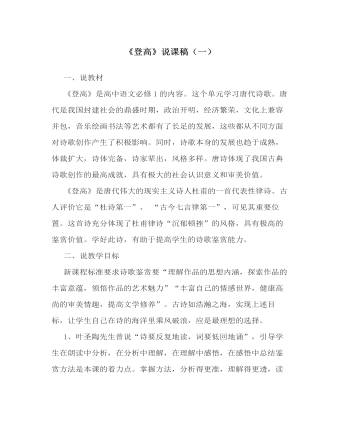
《登高》说课稿(一) 统编版高中语文必修上册
学生借助对对联的赏析,回味杜甫穷年漂泊的一生,体会杜甫作为一个深受儒家思想影响的读书人,忠君念阙,心系苍生的伟大情怀。(这一设计理念源于孟子所云:“诵其文,读其诗,不知其人,可乎?是以论其世也。”知人论世是鉴赏诗歌的第一步 )(二)研读课文1、初读,朗读吟诵,感知韵律美。要求学生读准字音,读懂句意,体会律诗的节奏、押韵的顺畅之美。2、再读,披词入情,感受感情美。让学生用一个字概括这首诗的情感内容。(此教学设计是从新课标要求的文学作品应先整体感知,培养学生归纳推理的逻辑思维能力出发进行的设计。)其答案是一个“悲”字,由此辐射出两个问题:诗人因何而“悲”?如何写“悲”?(此问题设计顺势而出,目的在于培养学生探究问题的能力。)
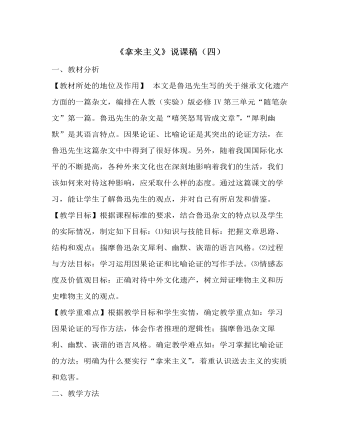
《拿来主义》说课稿(四) 统编版高中语文必修上册
【教学目标】根据课程标准的要求,结合鲁迅杂文的特点以及学生的实际情况,制定如下目标:⑴知识与技能目标:把握文章思路、结构和观点;揣摩鲁迅杂文犀利、幽默、诙谐的语言风格。⑵过程与方法目标:学习运用因果论证和比喻论证的写作手法。⑶情感态度及价值观目标:正确对待中外文化遗产,树立辩证唯物主义和历史唯物主义的观点。【教学重难点】根据教学目标和学生实情,确定教学重点如:学习因果论证的写作方法,体会作者推理的逻辑性;揣摩鲁迅杂文犀利、幽默、诙谐的语言风格。确定教学难点如:学习掌握比喻论证的方法;明确为什么要实行“拿来主义”,着重认识送去主义的实质和危害。二、教学方法教学应坚持“以学生为主体”的原则,尽可能发挥学生学习的能动性和主动性,培养学生独立思考的能力,调动学生学习积极性,因此本文采用“疑问教学法”相对合适。
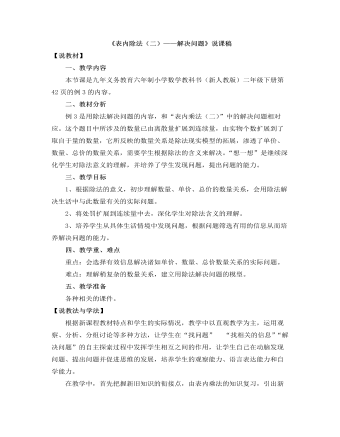
小学数学人教版二年级下册《表内除法(二)——解决问题》说课稿
一、教学内容本节课是九年义务教育六年制小学数学教科书(新人教版)二年级下册第42页的例3的内容。二、教材分析例3是用除法解决问题的内容,和“表内乘法(二)”中的解决问题相对应。这个题目中所涉及的数量已由离散量扩展到连续量,由实物个数扩展到了取自于量的数量,它所反映的数量关系是除法现实模型的拓展,渗透了单价、数量、总价的数量关系,需要学生根据除法的含义来解决。“想一想”是继续深化学生对除法意义的理解,并培养了学生发现问题,提出问题的能力。三、教学目标1、根据除法的意义,初步理解数量、单价、总价的数量关系,会用除法解决生活中与此数量有关的实际问题。2、将处罚扩展到连续量中去,深化学生对除法含义的理解。3、培养学生从具体生活情境中发现问题,根据问题筛选有用的信息从而培养解决问题的能力。
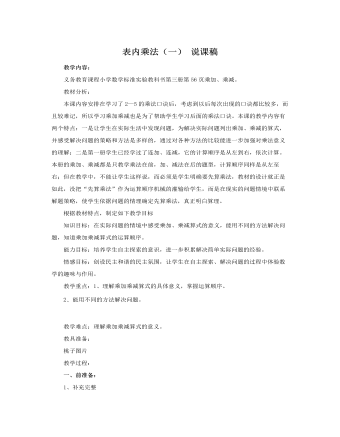
人教版新课标小学数学二年级上册表内乘法(一) 说课稿
本课内容安排在学习了2—5的乘法口诀后,考虑到以后每次出现的口诀都比较多,而且较难记,所以学习乘加乘减也是为了帮助学生学习后面的乘法口诀。本课的教学内容有两个特点:一是让学生在实际生活中发现问题,为解决实际问题列出乘加、乘减的算式,并感受解决问题的策略和方法是多样的,通过对各种方法的比较能进一步加强对乘法意义的理解;二是第一册学生已经学过了连加、连减,它的计算顺序是从左到右,依次计算。本册的乘加、乘减都是只教学乘法在前,加、减法在后的题型,计算顺序同样是从左至右;但在教学中,不能让学生这样说,而必须是学生明确要先算乘法,教材的设计就正是如此,没把“先算乘法”作为运算顺序机械的灌输给学生,而是在现实的问题情境中联系解题策略,使学生依据问题的情理确定先算乘法,真正明白算理。根据教材特点,制定如下教学目标知识目标:在实际问题的情境中感受乘加、乘减算式的意义,能用不同的方法解决问题,知道乘加乘减算式的运算顺序。
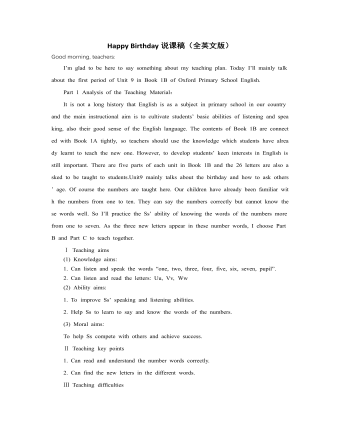
人教版新课标PEP小学英语三年级上册Happy Birthday(全英文版)说课稿
1. Do some exercise on the paper. There are four kinds of exercise here. The exercise 1 is to develop Ss’ ability of listening. Exercise 2 is to practice Ss’ ability of knowing the words. Exercise 3 is to develop Ss’ ability of speaking numbers and letters. Exercise 4 is to make Ss know the words and letters well. These exercises can consolidate the new knowledge from different styles of problems.2. Then tell Ss that we can sing the numbers like “ Do, re, mi, fa, so, la, ti, do” and let them listen to a song named “Do, Re, Mi”. Add some extra knowledge so that Ss will be glad to see that the numbers can be used in another way.Step 4 Homework1.Read the numbers from 1 to 7 and 7 to 1 five times.2.Read the letters “u, v, w” five times follow the tape.Reading is a useful way for the Ss of Grade One to practice the knowledge. Ask Ss to imitate reading from the tape in order to make Ss have a good habit of listening and let them have a better pronunciation.Step 5 Board writingI ‘ll put the seven numbers like a scale(音阶)as I’ll let Ss know that we can sing out the numbers. When it comes to listen to the song, I ‘ll draw a musical note on Bb. Unit 9 Happy birthday!sevensixfivefourthree U u V v W wtwo pupil five windowoneThat’s all for my class designing. Thank you for listening!